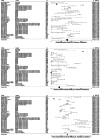Genetic and environment influences on childhood victimization: a systematic review and meta-analysis
- PMID: 39663379
- PMCID: PMC12014478
- DOI: 10.1038/s41380-024-02868-z
Genetic and environment influences on childhood victimization: a systematic review and meta-analysis
Abstract
Childhood victimization is a key risk factor for poor mental and physical health. In order to prevent childhood victimization, it is important to better understand its underlying etiological factors. Childhood victimization is not randomly distributed in the population but occurs more often in the context of certain characteristics of the child, the family, and the broader environment. These characteristics may be both genetically and environmentally influenced, making genetically informative designs valuable to disentangle the etiological factors. Here we performed meta-analyses of the genetic and environmental influences on childhood victimization based on twin studies. We also tested whether genetic and environmental influences on childhood victimization vary depending on key features of victimization experiences including the reporter of victimization experiences, the type of victimization, and the age at exposure. Following PRISMA guidelines, a search for relevant literature was conducted using MEDLINE, APA PsycInfo, and Embase databases until September 2023. A meta-analysis based on 21 studies with 62,794 participants showed that genetic influences accounted for 40% of the variance in childhood victimization, shared environmental influences for 20%, and non-shared environmental influences for 40%. In addition, we found that genetic and environmental influences on victimization varied based on the reporter and the type of victimization, and the age at victimization. The quantitative summary of genetic and environmental influences provided by this study advances our understanding of the mechanisms underlying risk for childhood victimization and points to prevention targets for victimization and its health effects.
© 2024. The Author(s).
Conflict of interest statement
Competing interests: The authors declare no competing interests.
Figures




References
-
- Danese A, Tan M. Childhood maltreatment and obesity: systematic review and meta-analysis. Mol Psychiatry. 2014;19:544–54. 10.1038/mp.2013.54 - PubMed
-
- Nelson J, Klumparendt A, Doebler P, Ehring T. Childhood maltreatment and characteristics of adult depression: meta-analysis. Br J Psychiatry. 2017;210:96–104. 10.1192/bjp.bp.115.180752 - PubMed
-
- Li M, D’Arcy C, Meng X. Maltreatment in childhood substantially increases the risk of adult depression and anxiety in prospective cohort studies: systematic review, meta-analysis, and proportional attributable fractions. Psychol Med. 2016;46:717–30. 10.1017/S0033291715002743 - PubMed
Publication types
MeSH terms
LinkOut - more resources
Full Text Sources

